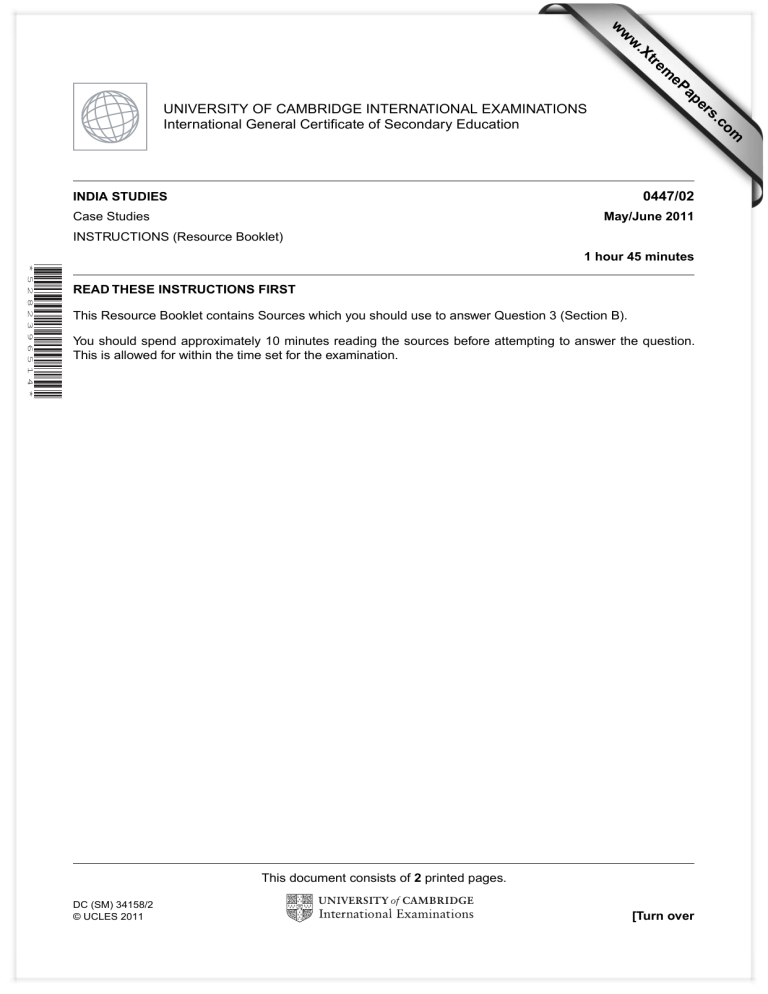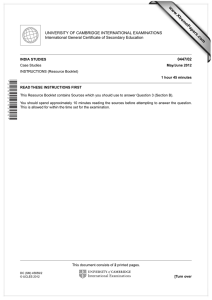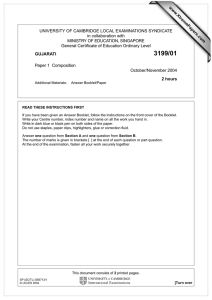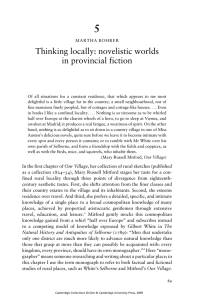www.XtremePapers.com

www.XtremePapers.com
UNIVERSITY OF CAMBRIDGE INTERNATIONAL EXAMINATIONS
International General Certificate of Secondary Education
INDIA STUDIES
Case Studies
INSTRUCTIONS (Resource Booklet)
0447/02
May/June 2011
1 hour 45 minutes
READ THESE INSTRUCTIONS FIRST
This Resource Booklet contains Sources which you should use to answer Question 3 (Section B).
You should spend approximately 10 minutes reading the sources before attempting to answer the question.
This is allowed for within the time set for the examination.
DC (SM) 34158/2
© UCLES 2011
This document consists of 2 printed pages.
[Turn over
2
Source A
1. India’s rivers, especially the smaller ones, have turned into toxic streams. Even big ones like the
Ganga and Yamuna are far from pure. The assault on India’s rivers – from population growth, agriculture, urbanisation, industrialisation – is enormous and growing by the day.
2. India has 16% of the world’s population and 4% of its fresh water resources.
3. It is estimated that about 66 million people in 20 states are at risk due to excess fluoride and around
10 million people are at risk due to excess arsenic in ground water.
4. Pollution of water from increased fertiliser and pesticide use in agriculture is a major concern.
Source B
1. Meeting the drinking water needs of a population as large as that of India can be a daunting task.
Despite an estimated total of Rs. 1,105 billion spent on providing safe drinking water since the First
Five Year Plan was launched in 1951, lack of safe and secure drinking water continues to be a major hurdle. The lack of uniformity in levels of awareness, socio-economic development, education, poverty and water availability all make the task more complicated.
2. Around 37.7 million Indians are affected by waterborne diseases annually. Some 1.5 million children are estimated to die of diarrhoea alone and 73 million working days are lost due to waterborne diseases each year. The resulting economic burden is $600 million a year.
3. In 2004–2005 through projects supported by organisations such as Water Aid, almost 325,000 people gained access to safe water in India.
Source C: possible approaches to improving the quality of life in rural India.
Approach 1: Improving water supplies. To improve water supply in rural areas, the government has encouraged a number of plans which have resulted in a significant improvement in water supply.
They have encouraged rainwater harvesting to recharge groundwater supplies. They have encouraged rooftop rain harvesting and the revival of traditional conservation structures such as tanks and ponds.
Approach 2: Improving rural housing. To improve rural housing, the Ministry of Rural Development implemented the Indira Awaas Yojana. This gives financial assistance to the rural poor to build houses.
Since the start of the scheme in 1986 over 181,000 houses have been built; in 2007–08 it was 19,880.
Approach 3: Improving rural sanitation. Rural sanitation is a major issue. However, areas like Shimla are close to becoming completely free from open defecation by 2011. The government has changed sanitation subsidies to include low cost latrines, which local people are trained to build and maintain.
Education programmes teach children about the need to wash hands before eating and after going to the toilet, with competitions held about hygiene to encourage involvement in the plans.
Permission to reproduce items where third-party owned material protected by copyright is included has been sought and cleared where possible. Every reasonable effort has been made by the publisher (UCLES) to trace copyright holders, but if any items requiring clearance have unwittingly been included, the publisher will be pleased to make amends at the earliest possible opportunity.
University of Cambridge International Examinations is part of the Cambridge Assessment Group. Cambridge Assessment is the brand name of University of
Cambridge Local Examinations Syndicate (UCLES), which is itself a department of the University of Cambridge.
© UCLES 2011 0447/02/INST/M/J/11






